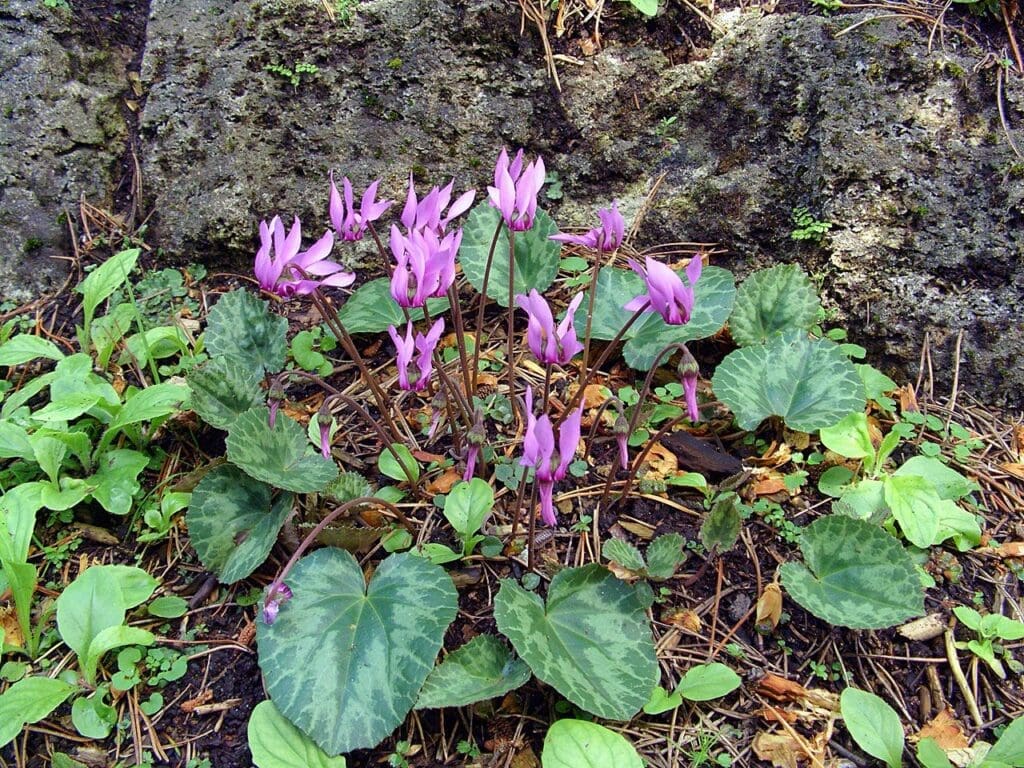
Cyclamen europaeum
Latin name: Cyclamen europaeum
Short name: Cycl
Common name: Cyclamen | Sowbread | Alpine Violet | European Cyclamen | Swinebread
Primary miasm: Psoric Secondary miasm(s): Sycotic
Kingdom: Plants
Family: Primulaceae
- Symptomatology
- Remedy Information
- Differentiation & Application
A perennial plant with tuberous roots native to Europe; contains bitter saponins and toxic triterpenes. Used homeopathically from the fresh root.
Traditionally used for menstrual and nervous complaints; toxic in crude form. Historically used to induce menstruation or abortion.
Proved by Hahnemann and first published in Materia Medica Pura. Additional insights from Hering and Clarke.
- Nervous system, especially visual disturbances, headaches, and faintness
- Menstrual system – disorders of menstruation and female cycles
- Mind – guilt, gloom, self-deprecation
- Circulation, with sluggish blood flow, coldness, and cyanosis
- Eyes – visual aura, flickering, and black spots
- Open air
- Walking slowly
- Motion in fresh air
- Eating (temporarily)
- Lying down (sometimes, in specific headaches)
- Warm room
- Before menses
- Standing still
- Fatty food, cake, or rich dishes
- Evening
- Suppressed emotions, remorse
- Sepia – Also melancholic with menstrual disturbance, but more detached, irritable, and indifferent
- Pulsatilla – Soft, yielding, tearful; also affected by menses, but less guilt-driven and more reactive to consolation
- Ignatia – Acute grief, sighing, and contradictory states, but more dynamic; Cyclamen is more subdued and slow
- Natrum mur. – Guilt and sadness with reserved disposition; but more structured, prideful, and dignified
- Lachesis – Suppressed emotion and menstrual disturbance, but more expressive, loquacious, and intense
- Complementary: Pulsatilla, Sepia
- Antidotes: Camphor, Coffea
- Inimical: Ferrum
- Follows well: Natrum mur., Ignatia
- Precedes well: Sepia, Lycopodium
Cyclamen represents the person who has lost their inner light—burdened by duty, weighed down by guilt, and withdrawn from joy. It suits those who sacrifice themselves, often without being asked, and develop illnesses after neglecting their own needs. The keynote is guilt with suppression, where the vital energy turns inward, creating vision problems, headaches, and irregular menstruation. Light returns to their system only when they allow themselves air, motion, and grace.
- Indispensable for menstrual migraines with visual aura
- Use for menstrual suppression after grief or guilt
- Suits quiet, melancholic women who reproach themselves for imagined faults
- Excellent in visual disturbances before menses
- Often helps headaches with flickering vision, especially if worse in warm rooms
Mind
- Guilt, exaggerated sense of
- Sadness, weeping, silent
- Aversion to company
- Desire for solitude
- Thoughts, wandering
Head / Eyes
- Headache, before menses
- Flickering before eyes
- Dim vision, aura
- Head, drawing backward sensation
Stomach
- Aversion to fat
- Nausea, before menses
- Hunger, with aversion to food
Female Genitalia
- Menses, suppressed
- Dysmenorrhoea with headache
- Leucorrhoea, acrid, milky
Generalities
- Warm room aggravates
- Open air ameliorates
- Weakness, faintness before menses
Samuel Hahnemann – Materia Medica Pura: Original proving symptoms, especially on head and visual field
James Tyler Kent – Lectures on Homoeopathic Materia Medica: Emotional themes of guilt and menstrual pathology
John Henry Clarke – Dictionary of Practical Materia Medica: Vision disturbances, menses, and cyclic nature of symptoms
William Boericke – Pocket Manual of Homoeopathic Materia Medica: Clinical uses in migraine, amenorrhoea, and eye complaints
C. Hering – Guiding Symptoms of Our Materia Medica: Expanded sensory and emotional symptoms
